Water resistance training offers you an ideal solution for strengthening aging muscles without joint stress. You’ll benefit from water’s natural buoyancy, which reduces compressive forces by up to 90% while providing consistent resistance for muscle development. Essential exercises like aqua squats, water push-ups, and underwater leg lifts target multiple muscle groups simultaneously. The hydrostatic pressure enhances circulation, reduces soreness, and supports bone density improvements that combat age-related muscle loss and osteoporosis concerns for extensive fitness benefits.
Understanding Water Resistance Training for Seniors
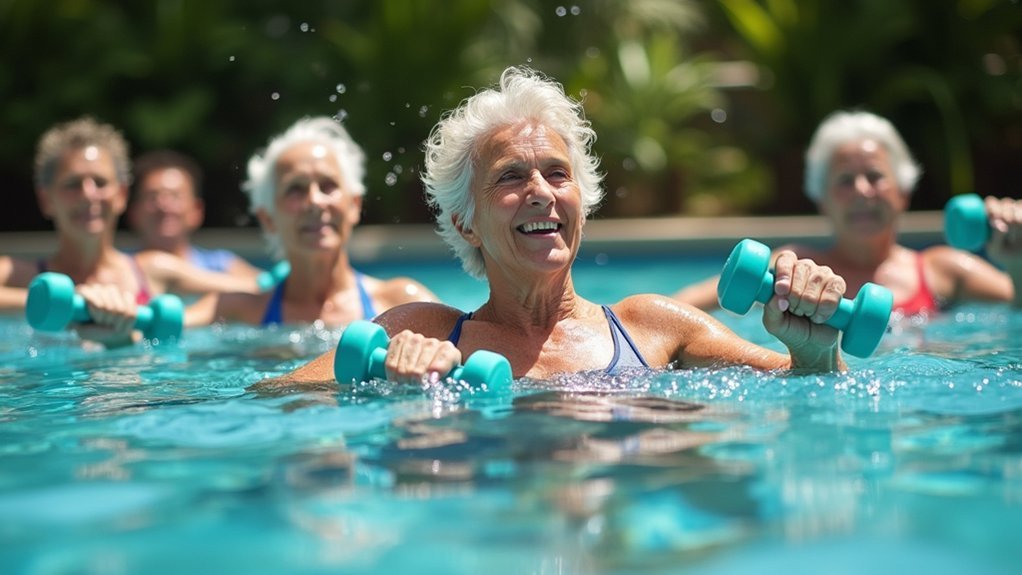
While traditional gym workouts can feel intimidating or cause discomfort as you age, water resistance training offers a gentler yet highly effective alternative for building strength. This low-impact method harnesses water’s natural resistance to engage multiple muscle groups simultaneously, making it perfect for seniors seeking safe strength training options.
Water’s buoyant properties considerably reduce joint stress while hydrostatic pressure enhances circulation and supports cardiovascular health.
You’ll find that exercises like squats and leg lifts become more comfortable in water, allowing you to focus on building muscle strength without pain. Regular participation improves bone density, flexibility, and functional fitness – essential elements for maintaining independence.
Water resistance training provides extensive benefits that contribute to your overall quality of life and mobility.
Benefits of Aquatic Strength Training for Aging Bodies
When you’re looking to maintain strength as you age, aquatic training offers unique advantages that land-based exercises can’t match.
You’ll protect your joints from harmful impact while water’s natural resistance challenges your muscles more effectively than traditional workouts.
This combination means you can build significant muscle strength while safeguarding the very joints that enable your daily activities.
Joint Protection Benefits
As you age, your joints bear the cumulative weight of decades of movement, making traditional strength training increasingly challenging and potentially painful.
Water offers a revolutionary solution for seniors seeking effective resistance training without compromising joint health. The natural buoyancy reduces compressive forces on your joints by up to 90%, dramatically lowering injury risk while maintaining muscle strength development.
Water’s hydrostatic pressure acts as a gentle compression garment, reducing inflammation and alleviating joint pain during exercise. This low-impact environment allows you to perform resistance movements that would be impossible on land.
You’ll discover improved flexibility as water supports your body through fuller ranges of motion. The result? Enhanced mobility in daily activities while protecting vulnerable joints from the wear and tear of conventional strength training methods.
Muscle Building Advantages
Three key mechanisms make water an ideal medium for building and maintaining muscle strength as you age.
Water resistance provides consistent force against your aging muscles throughout each movement, effectively increasing muscle mass without traditional weights. You’ll experience approximately 25% strength gains while hydrostatic pressure enhances circulation and reduces soreness, making workouts more comfortable.
Buoyancy supports your body weight, allowing greater range of motion that promotes flexibility while preventing injury to vulnerable joints. This expanded movement capability helps develop muscles more thoroughly than land-based exercises.
Additionally, aquatic training stimulates bone remodeling, fighting osteoporosis naturally. The combination of resistance work and constant movement also boosts cardiovascular fitness, creating a complete workout system that addresses multiple aspects of healthy aging simultaneously.
Essential Water-Based Exercises for Muscle Development
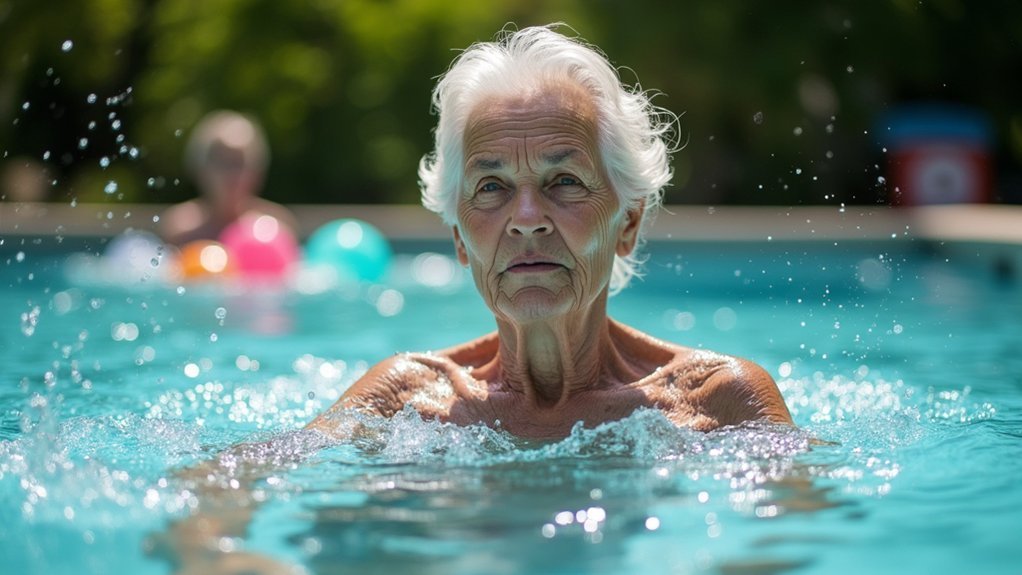
While traditional land-based exercises can strain aging joints, water-based workouts offer a gentler yet highly effective approach to building muscle strength. The buoyancy of water creates a low-impact environment that’s perfect for aging muscles while simultaneously providing natural water resistance for muscle development.
Water’s buoyancy protects aging joints while its natural resistance effectively builds muscle strength in a low-impact environment.
These essential exercises target multiple muscle groups effectively:
- Aqua squats engage your lower body muscles using water resistance while protecting your joints from excessive stress.
- Water push-ups build upper body strength by leveraging hydrostatic resistance to target your chest, shoulders, and arms safely.
- Water jogging delivers cardiovascular benefits while strengthening your core and legs simultaneously.
Leg lifts performed underwater enhance hip strength and flexibility, while resistance bands maximize versatility in your water-based strength training routine.
Hydrostatic Pressure and Its Role in Muscle Strengthening
When you exercise in water, hydrostatic pressure automatically increases the resistance your muscles encounter at every depth. This unique pressure engages multiple muscle groups simultaneously, making your workouts more effective for muscle strengthening than traditional land-based exercises.
For aging populations, this low-impact environment provides essential joint support while delivering powerful resistance training benefits.
The combination of hydrostatic pressure and buoyancy creates an ideal setting where you’ll experience enhanced circulation during workouts, promoting faster muscle recovery and reduced soreness.
This supportive environment helps combat sarcopenia by allowing you to maintain and build muscle mass safely. Water’s natural resistance also improves your flexibility and stability, vital factors for preserving muscle function as you age.
Safety Considerations for Water Resistance Workouts
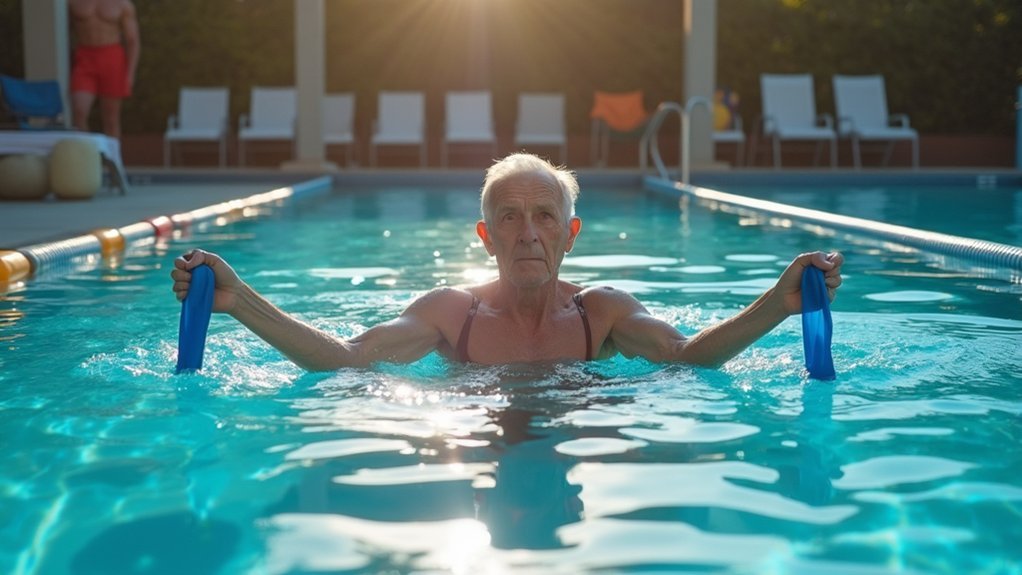
Although water resistance workouts offer remarkable benefits for muscle strengthening, you must prioritize safety to maximize these advantages without risking injury. These safety considerations guarantee effective injury prevention during your aquatic exercise routine.
Before beginning any water resistance program, consult healthcare providers to evaluate your individual health conditions and physical limitations. This professional guidance helps determine appropriate exercises for your specific needs.
Essential safety measures include:
- Proper Equipment: Wear appropriate swimwear and non-slip water shoes to prevent dangerous slips and falls around pool areas.
- Pre-Exercise Preparation: Always warm up with gentle water movements to reduce risk of muscle strains and joint injuries.
- Body Awareness: Stay hydrated throughout sessions and listen to their bodies, immediately stopping if you experience pain discomfort or unusual fatigue.
Equipment Options for Enhanced Aquatic Training
The right aquatic equipment transforms your water-based strength training from basic movements into targeted muscle-building sessions.
Water dumbbells and resistance bands offer adjustable resistance for muscle strengthening in this low-impact environment, minimizing joint strain while maximizing results. You’ll find aquatic noodles provide buoyancy support and enhanced core stability during various exercises.
Adding ankle weights to leg lifts intensifies lower body workouts without impact risks. Kickboards excel for water jogging and swimming drills, letting you concentrate on arm movements while maintaining stability for upper body strengthening.
Aqua belts keep you buoyant in deeper water, enabling greater range of motion across all muscle groups. This equipment combination guarantees you’re getting effective resistance training that’s both safe and challenging for aging muscles.
Creating an Effective Water Resistance Routine
How do you design a water resistance routine that maximizes muscle-building benefits while protecting your joints? Start with foundational movements in this low-impact environment that’ll build strength effectively. Water walking combined with aerobic movements creates an excellent base for your fitness goals.
Structure your routine around these key elements:
- Core exercises: Incorporate water walking, aqua squats, and leg lifts to engage multiple muscle groups simultaneously.
- Progressive intensity: Add resistance tools like water dumbbells or increase movement speed to boost muscle activation.
- Consistent scheduling: Aim for 30-60 minute sessions 2-3 times weekly, allowing proper recovery between workouts.
Expand your range of exercises gradually, including water push-ups and resistance band routines.
Always monitor your body’s response to maintain proper form and prevent injuries while progressing toward overall fitness improvement.
Who Should Consider Water-Based Strength Training
You’ll find water-based strength training particularly beneficial if you’re recovering from an injury and need a gentler approach to rebuilding muscle.
If you’re experiencing joint pain or stiffness that makes traditional weightlifting uncomfortable, the buoyancy of water can provide the support you need while still challenging your muscles effectively.
As an aging adult, you can maintain and even build strength through water resistance exercises without the harsh impact that often comes with land-based workouts.
Injury Recovery Patients
Millions of injury recovery patients find themselves caught between two competing needs: maintaining muscle strength while protecting vulnerable tissues from further damage.
Water provides the perfect solution through its unique therapeutic properties that support healing while preventing setbacks.
The buoyancy of water creates an ideal environment where you’ll experience:
- Reduced joint stress – Hydrostatic pressure minimizes impact while you rebuild strength
- Enhanced muscle engagement – Water resistance exercises target multiple muscle groups simultaneously
- Accelerated healing – The low-impact nature supports tissue recovery while maintaining muscle mass
Rehabilitation programs incorporating water-based training help you improve overall mobility without compromising your recovery.
You’ll reduce the risk of re-injury while regaining function, enabling a safer return to daily activities.
Aging Adults
Beyond injury recovery, aging adults over 65 represent another population that can dramatically improve their quality of life through water-based strength training. The low-impact environment reduces joint strain while maximizing muscle engagement, making it ideal for maintaining strength without discomfort.
| Traditional Gym Training | Water Resistance Training |
|---|---|
| High joint stress | Gentle on joints |
| Risk of falls | Buoyancy support |
| Limited flexibility work | Enhanced flexibility |
| Single-focus workouts | Multi-benefit sessions |
| Intimidating environment | Comfortable setting |
Hydrostatic weight training offers extensive benefits for aging adults, improving cardiovascular fitness while building muscle strength. You’ll notice enhanced balance and coordination, plus effective weight management. Water’s natural resistance challenges your muscles differently than traditional weights, promoting better overall fitness outcomes for seniors seeking sustainable exercise solutions.
Joint Pain Sufferers
Living with chronic joint pain doesn’t mean you have to abandon strength training altogether. Water resistance training offers you a perfect solution by creating a low-impact environment that protects your joints while building muscle strength effectively.
Aquatic exercise provides three key advantages for managing your condition:
- Enhanced circulation – Hydrostatic pressure reduces inflammation and alleviates arthritis-related discomfort.
- Improved flexibility – Water’s supportive properties help increase your range of motion safely.
- Reduced injury risk – Buoyancy eliminates fall hazards while maintaining workout intensity.
Whether you’re among active seniors or recovering from injuries, water-based training adapts to your specific needs.
You’ll find the confidence to maintain consistent physical activity without compromising your joint health, making aquatic exercise an ideal long-term fitness solution.
Frequently Asked Questions
Does Water Resistance Build Muscle?
You’ll build muscle through water resistance since hydrostatic pressure creates extensive resistance that engages multiple muscle groups simultaneously. Water’s resistance stimulates muscle hypertrophy while reducing joint strain compared to traditional weight training.
What Is the Best Water Exercise for Seniors?
Water walking’s your best choice since it improves cardiovascular fitness while engaging your lower body muscles. You’ll experience minimal joint strain, making it ideal for building strength and endurance safely in the pool.
Can You Build Muscle With Water Weights?
You can build muscle with water weights through consistent resistance training. Water’s buoyancy creates effective resistance that stimulates muscle hypertrophy and strength gains, comparable to traditional weights while reducing injury risk considerably.
Does Resistance Training Slow Aging?
Yes, you’ll slow aging through resistance training. It counteracts muscle loss, increases strength by 20-40%, improves bone density, enhances balance for fall prevention, and boosts mental health, helping you maintain independence longer.
In Summary
You’ll find water resistance training transforms your aging muscles while protecting your joints from unnecessary stress. Don’t let age limit your strength potential—embrace aquatic workouts that deliver real results without the harsh impact of traditional weight training. Start with basic movements, progress gradually, and you’ll discover renewed muscle power you didn’t think was possible. Your body deserves this gentler yet effective approach to staying strong and independent.

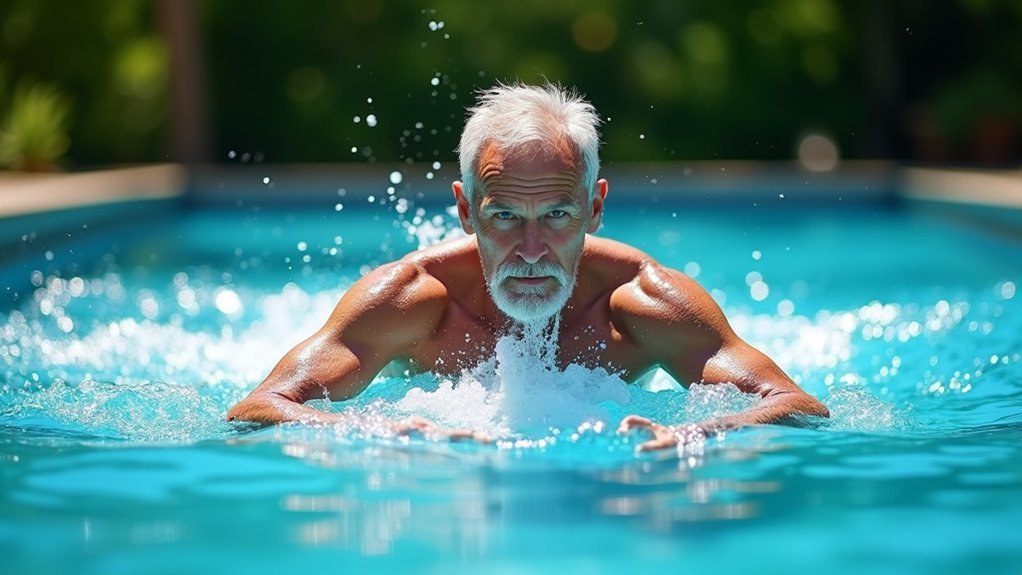
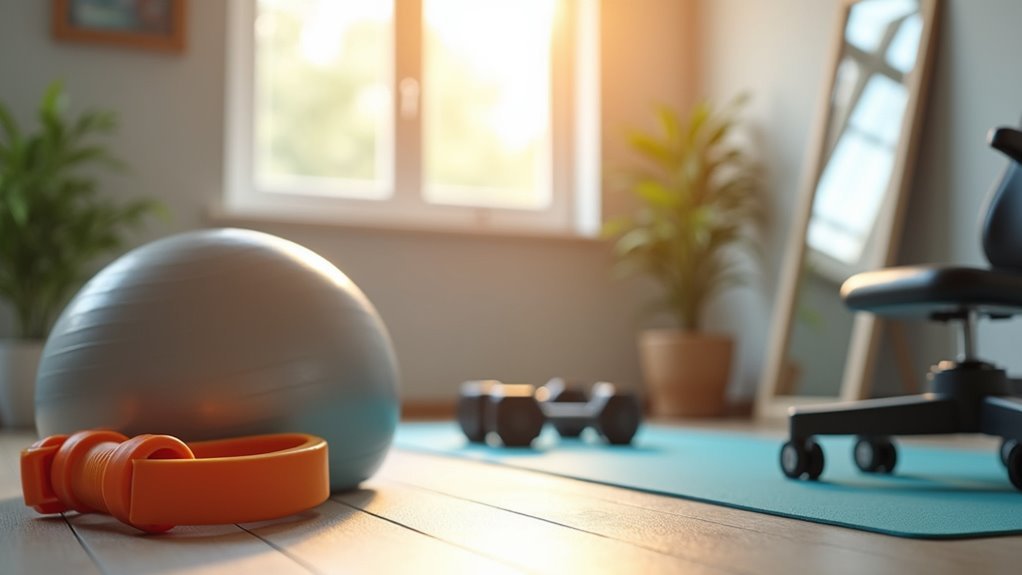
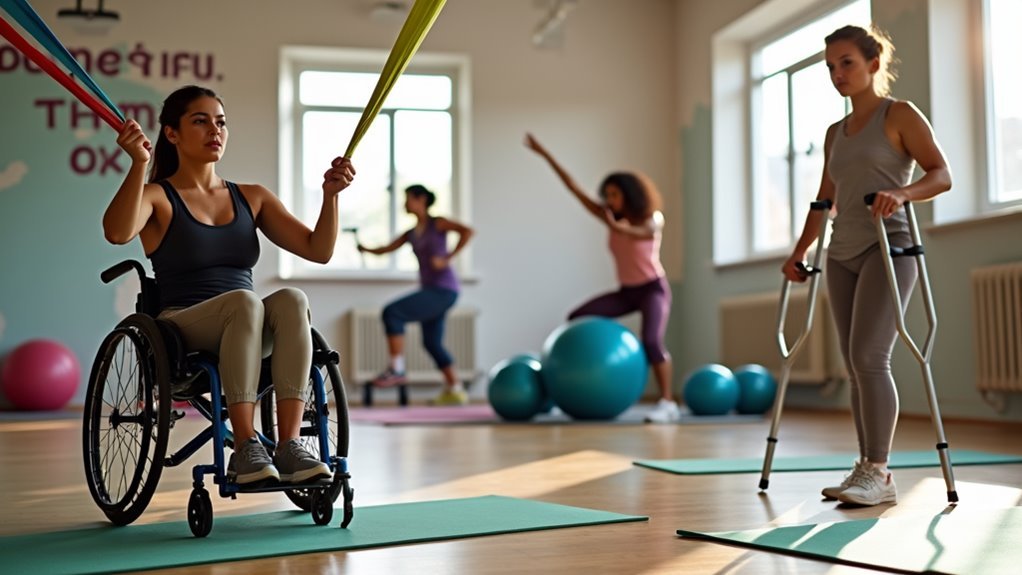
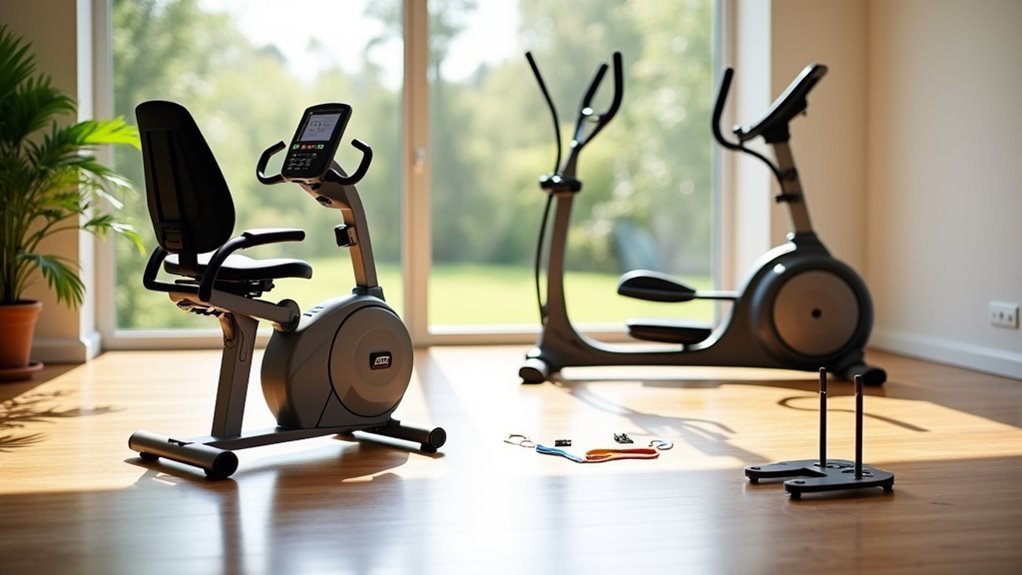
Leave a Reply